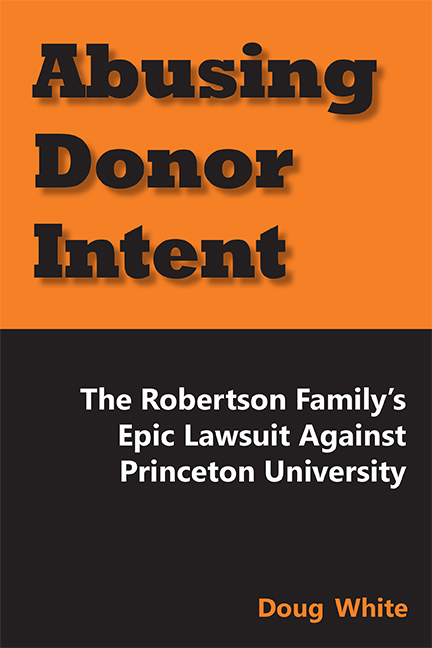It was the largest one-time amount—$35 million—anyone had ever donated to benefit a university. The Robertsons were specific about the way the money was to be used. It was intended to help Princeton’s Woodrow Wilson School of Public and International Affairs focus on sending its graduates into those areas of the federal government concerned with international relations. “But the university,” the son says, “was ignoring my parents’ intentions.” Furthermore, Princeton’s administrators were “harming the country.” That’s not, as you might imagine, the way Princeton saw it—or sees it today.
How much control over a gift does a donor have after the gift is given?
How accountable is a non-profit recipient for the use of the gift?
“Abusing Donor Intent tells the story, which if written as fiction would generate incredulity in its portrayal of how top brass at Princeton University for so long callously disregarded the wishes of Charles and Marie Robertson for their then immense gift of $35 million (in 1961) being deployed to promote the education of young Princetonians for government service in foreign lands.”
—Jim Watson, Chancellor Emeritus, Cold Spring Harbor Laboratory, Recipient of the 1962 Nobel Prize for the discovery of the DNA double helix
“Doug White’s careful and fair study of the seminal Robertson Foundation endowment litigation against Princeton University should be read by all donors and donees. As a former head of the New York State Law Department’s Charities Bureau, I know donors have to have both courage and resources to enforce their rights, especially against iconic donees. Fortunately, the Robertsons had both.”—Bill Josephson, Former head of the Charities Bureau, New York State Attorney General’s office
“Robertson v. Princeton, the mother of all donor intent cases, is must-know material for everybody involved in the giving or receiving of large charitable contributions. Happily for his readers, Doug White has turned what could have been a dry legal text into an engaging human story. The lessons to be learned, which are both heuristic and institution-shaking, go down easily in his smooth narrative."—Neal B. Freeman, Chairman, Foundation Management Institute"Who cares about donor intent? Donors do. And therefore they need to heed Ronald Reagan’s dictum: “Trust but Verify.” As Doug White outlines in his engaging new study, replete with fascinating family history, arrogant administrators, and trusting donors, there are far too many illustrations of institutions simply disregarding donor intent and turning aside questions from donors who are wondering if their wishes are being followed. The infamous Robertson case against Princeton University--in which Princeton ultimately paid tens of millions of dollars to the Robertson family--is a clarion call to donors everywhere to demand clarity of expectations, clear communication of results, and strict regard for donor intent. —Anne D. Neal, President, American Council of Trustees and Alumni, Co-author, The Intelligent Donor’s Guide to College Giving
"As a philanthropist I am very interested in how charities use their money. As the nonprofit sector grows increasingly important and vibrant around the world, society needs to better understand the relationship between those who support good causes and the organizations that put donated money to use. Doug White’s narrative is at once engaging and exacting. And while he even-handedly examines the legal arguments in Robertson v. Princeton, he also describes a family’s humanity—a dimension of the philanthropic process that is far too often overlooked. Abusing Donor Intent will undoubtedly be the authoritative chronicle of this epic lawsuit, as well as an indispensable guide for all charities and future philanthropists."—Dame Stephanie Shirley, Philanthropist, The British Government’s Founding Ambassador for Philanthropy, 2009-2010, Author, Let It Go
"Can the phrase, 'The Arc of Embezzlement,' play a credible role in a book about finances at an Ivy League university? Read on. Doug White's meticulous, patient research documents a story about a massive moral ill in our nation today: the unregulated billions of untaxed dollars in the endowments of the nation's wealthiest colleges and universities. The trustees and university officers managing these endowments are accountable to no one and can operate with reckless disregard for the purpose of the charitable dollars in their control. Doug White's story would strain belief as fiction—but this story is true."—Wick Sloane, Author of "The Devil's Workshop," Inside Higher Ed, Former Visiting Fellow, Higher Education, Federal Reserve Bank of Chicago
This book is based on extensive research and interviews with leading attorneys Victoria Bjorklund and Douglas Eakeley (Princeton) and Ron Malone and Seth Lapidow (Robertson family), experts for both sides, representatives of other major nonprofits, philanthropists, and high-profile public figures including George H.W. Bush, Brent Scowcroft, Chuck Robb, and Paul Volcker.




